Nebraska I-Formation Offense
Historical Background
Tom Osborne would finish his career with a record of 255-49-3 after coaching at the University of Nebraska from 1973 through 1997. Despite his on field success, many college football fans remember his dominant offensive attacks.
ESPN’s Page 2 listed the 1995 Nebraska team 3rd on their Top 10 college football teams of all-time.
Starting as offensive coordinator, he favored a downhill power running scheme out of the I-Formation. The I-Formation is best known for a Quarterback under center with a Fullback and Running Back behind him lined up in an I. Variants of the formation including stacking the Fullback behind the Tackle on the right or left side, often times called Strong (if the TE is lined up) or Weak (away from the TE).
Nebraska commonly used a handful of formations during the 1970’s leading up to the 1980 season. They mostly utilized the basic I-Formation, an Ace formation with 1 RB and 2 TEs, and Twin formations putting 2 receivers on the same side of the field out of the I-Formation and Ace formation.
During the 1980’s and especially the 1990’s, Osborne started experimenting with more formations including 3 WR looks out of Ace, I-Formation, and even a 4 WR Shotgun formation. One of the more interesting inclusions is the Double Wing formation, much better known as the basic formation in the Flexbone option offense utilized by Army, Navy, Air Force, and Georgia Tech currently at the FBS level.
In 1980, Tom Osborne made the biggest breakthrough of his offensive system by marrying the option run to the downhill power game out of his pro formations. Quarterback Jeff Quinn improved from 75 carries in 1979 (average of 7 per game) to 108 carries in 1980 (average of 10 per game).
By the mid 1980’s, Osborne was known as much for the prolific option aspect of his offense thanks to athletic running quarterbacks such as Turner Gill, Steve Taylor, and Gerry Gdowski. His offense really took off in the 1990’s with the inclusion of Tommie Frazier and Scott Frost, who transferred from Stanford.
One of the more overlooked aspects of Osborne’s offense is his ability to play call during games but also how regimented the offense itself was. A lot of people think of his Nebraska teams as being more heavily option oriented than they really were. Osborne himself stated that he ran the option maybe 25 to 30 percent and ran a lot out of the I.. The heart of his offense was the downhill pro style running game that helped his players transition well to the NFL. Head Coach John Fox said that if he were to employ an option offense he would want it to resemble Tom Osborne’s offense at Nebraska.
A lot of the plays were fairly simplistic in terms of the actual running game: Dive, Trap, Stretch, Pitch, Counter (Sweep and Trap), Iso, and Draw. That is not including the Speed Option either.
Another interesting note is that calls to the Fullback were often designed specifically as hand-offs to the Fullback as opposed to modern day where the QB reads the defense and decides the read.
The blocking is primarily man-on-man but also included a lot of chop blocks. When the NCAA banned this technique in 1980, Nebraska continued to utilize the cut block (where a defender is not engaged with a teammate).
Looking At the Offense
Credit to Jeamillio for the 1995 Nebraska vs Michigan State clip. Worth mentioning is that Nick Saban (currently the head coach of Alabama) was head coach of Michigan State at the time and coming off a season as defensive coordinator of the Cleveland Browns, who had the least points allowed that year.
Nebraska initially lines up in I-Formation against an over 4-3 look with an OLB looking at possibly rushing in off the edge. Nebraska will run a speed option to the left with the QB riding the FB before pulling the ball and setting up the outside LB as the pitch key.
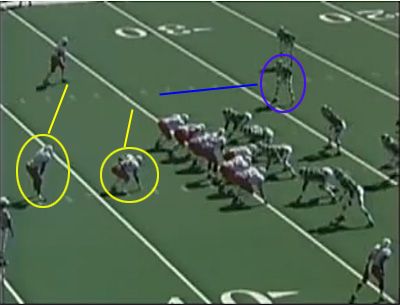
The LG pulls around to the left, cut blocking a DE to the ground. After the QB fakes to the FB, that allows the FB to go head up as a lead blocker on the MLB leaving the OLB as the lone unblocked defender. If the WR can maintain his block, it should lead to a solid gain.
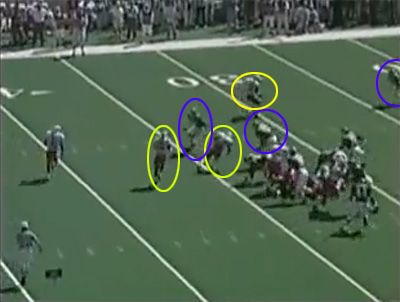
The FB cut blocks the MLB and the OLB takes out the QB. That simply leaves the trailing OLB, with a lot more ground to try to cover, as the last resort in terms of taking out the I-Back for a minimal gain. Take note that the pursuing OLB now has a poor angle as a result of the sound execution by the QB to pitch it at the very last second. This play also is a great example of how proper execution made Nebraska’s offense much more efficient and tough to defend.
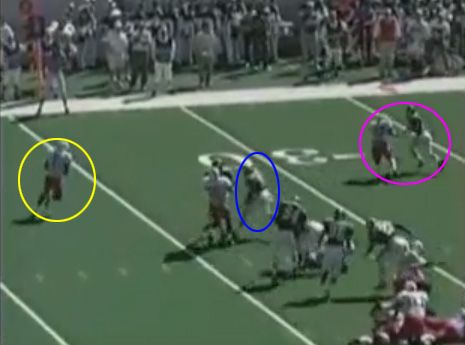
As a result of the execution, the I-Back gets a very good gain of 13 yards on the run taking the ball from the 34 yard line down to the 21 yard line.
Here is an example of the power running game that Nebraska was utilizing throughout Tom Osborne’s tenure as head coach. Credit to oviedol55 for the highlight video of RB Ahman Green.
Nebraska lines up in a 3 WR set of of the I-Formation against a loaded defensive line showing 4 men with an OLB blitzing off the single WR side of the formation.
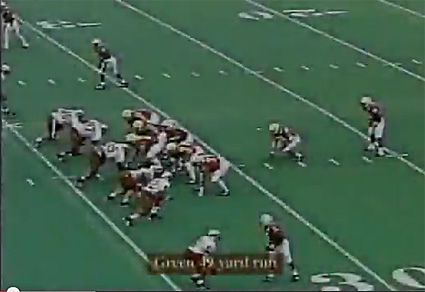
Upon the hand-off, the player lined up over the slot WR ends up rushing in but over pursues, taking himself out of position to make a tackle. The FB leads the way up the field while the offensive line and wide receivers go man-on-man blocking wise. Again the execution and strength of the offensive line immediately overwhelm the defense. Take note of the attempted cut block by the WR on the near side CB as well.
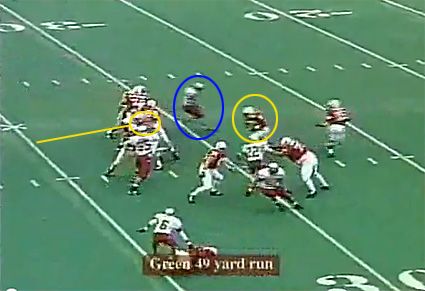
The Fullback completely stone walls the linebacker allowing Green a gaping hole to either the right or the left. Green bursts forwards with only the CB, who was able to avoid the cut block, with a chance to make an immediate tackle. This is also an example where if the WR had properly executed, the CB would be well out of the play.

Green uses his speed to beat out the CB, stiff arms the deep safety just enough to take him out of the play, and is off to the races for a long run of 49 yards. As Green does this in the middle of the field, the far side WR also fails to take his CB out on a cut block. Green ends up being taken down at the 5 yard line thanks to a great angle and great speed from the other deep safety.
The above two runs are merely a speck of a glimpse at his offense and it is well worth trying to track down clips and full games on Youtube.
Tom Osborne managed to transform Nebraska into a powerhouse on both sides of the ball but his downhill power scheme, married to the outside speed option (and athletic quarterbacks), really helped set the pace for his dominance. His offense was also a precursor to the modern day schemes that marry power with option running such as the Pistol, developed by Chris Ault at Nevada, and the zone read option offenses taking over the CFB and NFL landscapes.
While Osborne’s teams may have been loaded with speed and talent, the execution from all 11 players on offense were all incredibly sound and helped make his offenses the dominant running attacks that they were year in and year out.
Featured Image: Credit to Nebraska/Getty Images


One Comment
Leave a Reply